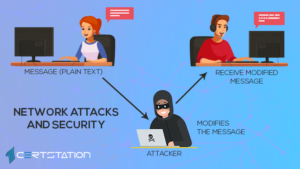
What is wireless security?
Wireless security is precisely designed to keep unlawful users from accessing an individual wireless network and making off with important information. The type of wireless security used by a person is recognized by its wireless protocol. Today, many households and organizations operate and depend on wireless networking. Wi-Fi, for instance, is extremely efficient in keeping users linked to the internet 24 hours a day. This important benefit, together with the fact that it comes without a mess of cables, makes wireless networking much more appealing.
However, since Wi-Fi signals can be broadcast beyond a home or a company, Wi-Fi is liable to be attacked by criminals, increasing easy access by people in adjacent houses or even individuals in a nearby parking lot. This is where it’s very important to ensure strong wireless security. You may be wondering what the threat, if at all any, of other persons accessing your Wi-Fi is. Well, there are several pitfalls to a susceptible wireless network. For example, criminals will be able to access personal information, steal your identity, and use it against you. In many cases, individuals have ended up in jail for a crime they did not commit through the internet.
What Are the Wireless Security Protocols?
Wireless protocols are intended to defend wireless networks used within households and other types of buildings from cybercriminals. Four wireless security protocols exist, each with different strength and capacity. Wireless protocols also encode private data as it is being broadcast over the radio frequencies, which then guards your private data from criminals and unintentionally protects you.
Here’s a detailed look at the type of wireless protocols that is important for everyone to know.
The Wired Equivalent Privacy (WEP): Designed in 1997, this is the first wireless security protocol ever developed, and is still widely used today. Notwithstanding, it is regarded as the faultiest and least safe wireless security protocol to use.
The Wi-Fi Protected Access (WPA): This protocol is designed to handle the faults that exist with the WEP protocol. Remarkably, it employs the Temporal Key Integrity Protocol (TKIP) and preshared key (PSK), among others, for encryption.
The Wi-Fi Protected Access 2 (WPA 2): This is accompanied by improved features and encryption capabilities. For example, the WPA 2 uses Counter Mode Cipher Block Chaining Message Authentication Code Protocol (CCMP) rather than (TKIP, which is known to be effective in encoding data. Therefore, WPA 2 is regarded as the best wireless security protocol.
The Wi-Fi Protected Access 3 (WPA 3): A recent wireless protocol, WPA 3 is improved due to encryption capabilities and steering clear of hackers from both private and public networks.
Types of Wireless Attacks
Wi-Fi networks can be susceptible to a number of diverse attacks; therefore, it’s imperative to be aware of them so the necessary steps can be taken to avert and decrease their impact.
Here are some major types of wireless attacks:
Peer-to-peer Attacks
Devices that are linked to the same access points can be susceptible to attacks from other devices linked to that access point. Most providers offer an option such as “Client Isolation” which guarantees that clients linked to the access point cannot communicate with each other, averting this problem.
Eavesdropping
Wireless communications are monitored here. There are two types of eavesdropping. The first, casual eavesdropping, is where a wireless client vigorously scans for wireless access points. The second type, malicious eavesdropping, is the unlawful kind, where someone tries to tap the data moved between clients and the access point. Therefore, it is important to encode your networks, as anything unencrypted can be eavesdropped.
Encryption Cracking
This is where the hacker seeks to snap the encryption on the network. WEP networks are the most vulnerable to this, since they can be effortlessly cracked in just 5 minutes. It is significant to make sure that the most secure encryption be used.
Authentication Attacks
This is where the hacker fixes a frame exchange between a client validating with the network, and then they merely run a disconnected dictionary attack. With this kind of information, and contingent on the strength of the password, it could be just a matter of time before the hackers can blow the password and gain access. Hence, you must keep your login information as secure as you can.
MAC Spoofing
This is an enormously easy thing to do. Due to this, using MAC filtering to control which devices can link to your network is not safe at all. It can, nevertheless, be used in combination with other security measures to build up a general more secure network architecture.
Social Engineering
As opposed to prevalent belief, most effective hacks are not attained through scripts, software or tools, but by virtue of social engineering. This is a method used to manipulate people into spreading information, such as computer passwords, or information that will help hackers restrict possible passwords. The best way to handle this latent threat is to ensure that people are well aware of security measures such as changing passwords frequently, and not sharing private information.
7 Ways to Increase Your Wireless Network Security
1- Set robust router password
2- Set up WPA2 encryption
3- Use a strong VPN
4- Choose your wireless router’s positioning carefully
5- Ensure you turn your wireless network off when not in use
6- Stay updated for news about vulnerabilities in your devices
7- Disable remote router admin access
Conclusion
Everyone interested in keeping the data safe and secure must ensure they protect the home network on top priority. These measures can be really valuable even for those with little knowledge of technology. Also, your wireless network security can be occasionally weak, and vulnerable to being abused. It nearly doesn’t matter how strong your password is or whether your software is up-to-date if hackers can just capture your Wi-Fi data. You still have to be watchful for uncertain Wi-Fi routers out there, however, since most will possibly still use WEP and not abide by these safety protocols.




